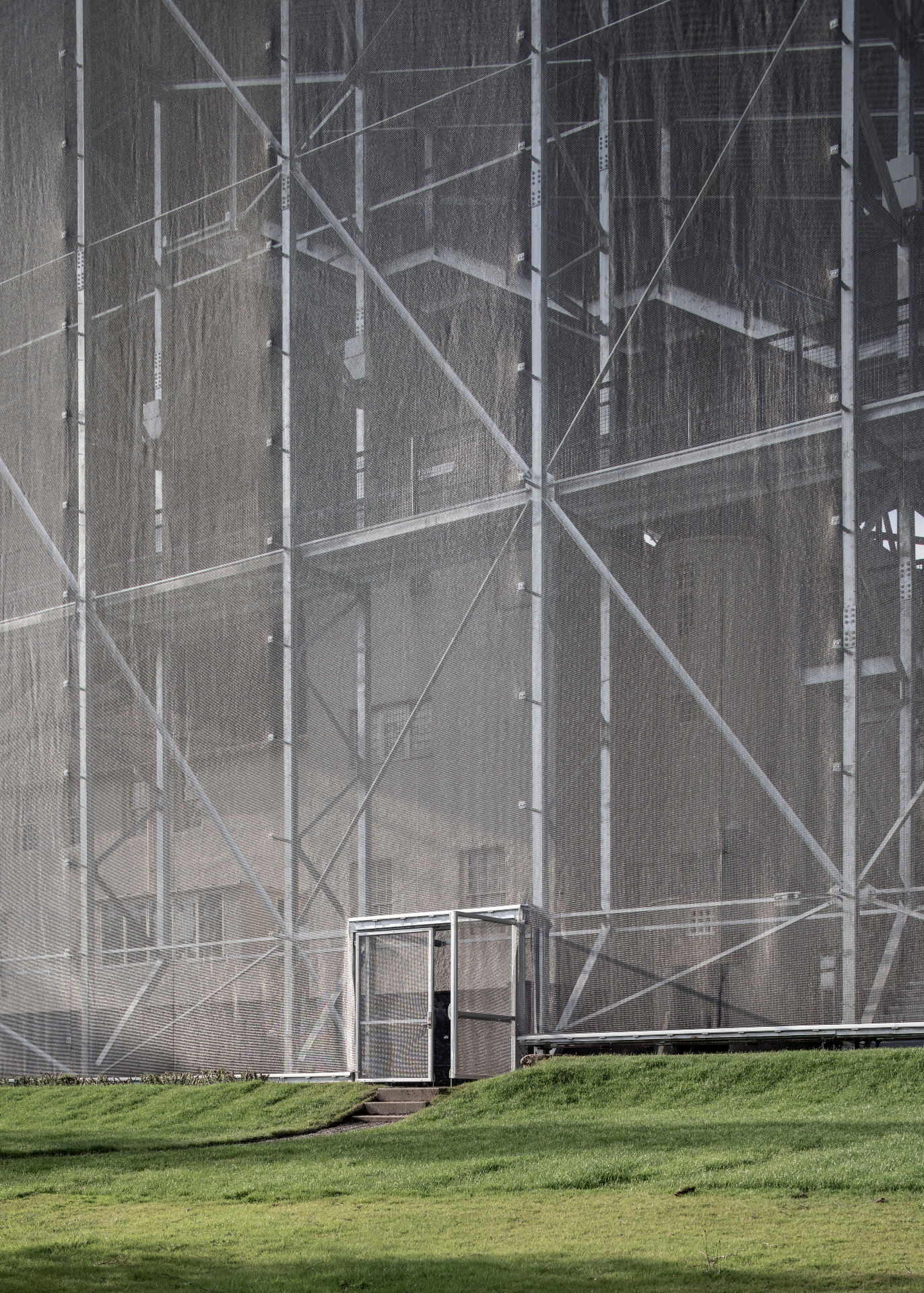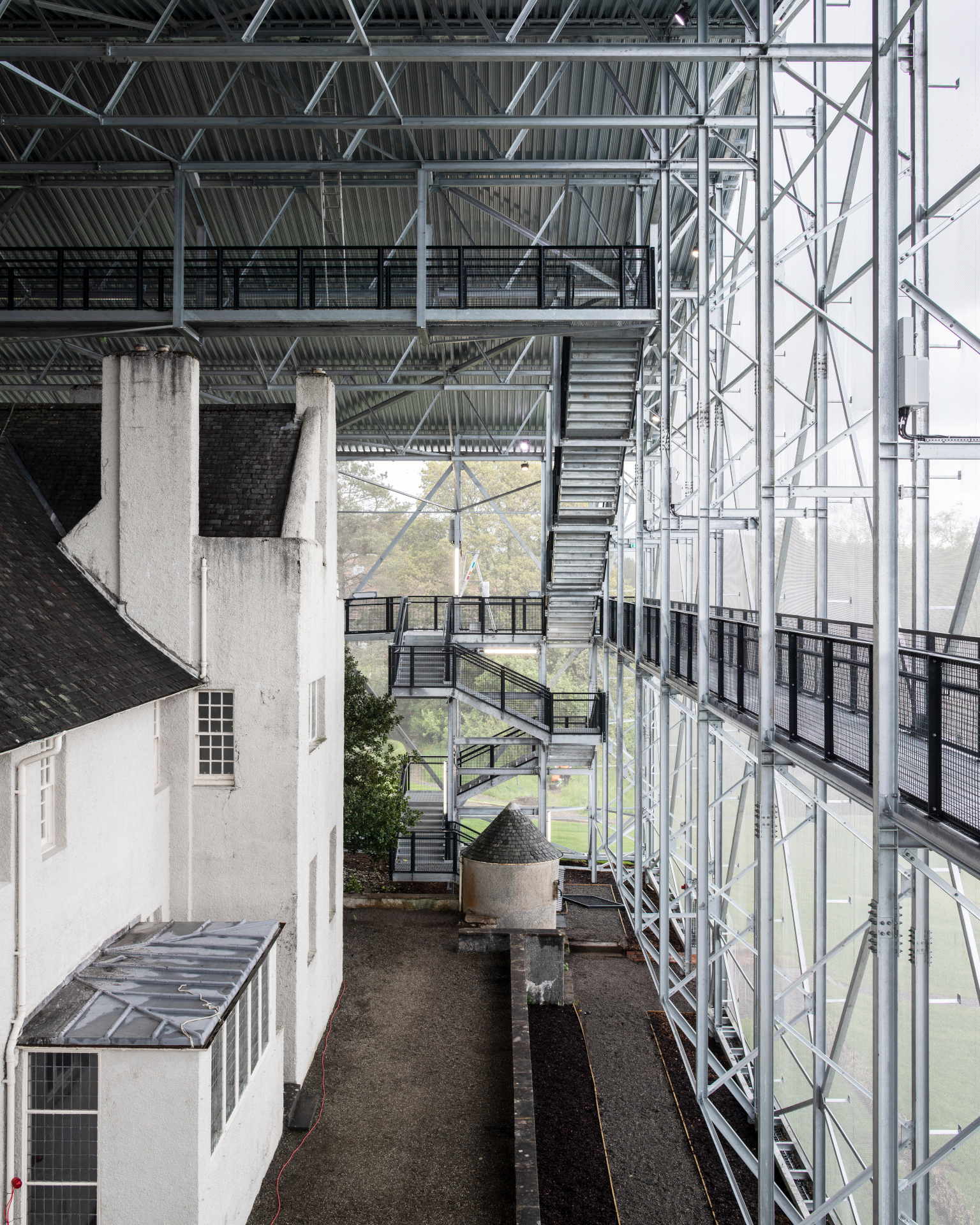Inside Carmody Groarke’s Hill House Box in Scotland

The world-renowned Hill House in Helensburgh is not only Charles Rennie Mackintosh’s domestic masterpiece, a rare living monument embodying the architect’s ‘gesamtkunstwerk’ approach where every element of the house from the building to the furniture and interiors was designed by Mackintosh (with wife Margaret Macdonald). But in its bold formal abstraction – a distillation of Scottish vernacular Baronial architecture with Japanese minimalism and European Arts and Craft leitmotifs – the building is an important Modernist precursor. It’s also on its last legs.
‘It’s only got two or three serious winters left in it,’ says architect Andy Groarke of Carmody Groarke, who has been tasked with creating an architectural intervention to allow a reprieve for this hilltop landmark, designed and built in 1904 for enlightened Glasgow publisher Walter Blackie and his family.
‘The Hill House is built of soft red sandstone and a brick amalgam, buttered in this sand cement render,’ Groarke explains. ‘Mackintosh was looking to create the imagery of abstraction and cement render offered this potential. However, whereas local vernacular materials such as lime render breathe, cement doesn’t.’
Consequently, over a century of battering winds and rain on this exposed site (Helensburgh experiences 193 days of year a year on average) has had an effect on the building akin to ‘an aspirin dissolving in water,’ according to the National Trust for Scotland, who have been custodians of the building since 1982. Various attempts to solve the problems over the years have been ad-hoc and ultimately fruitless. Consequently NTS decided to take bold and decisive action in 2017 and invite submissions, via an architectural competition, for design solutions that would ensure the long-term survival of the building and its unique, intact interiors (currently deploying buckets to catch dripping water).
Carmody Groarke’s winning design, the Hill House Box, is variously ‘a drying room’ and protective ‘field hospital with one patient, the Hill House inside,’ according to Groarke. ‘The project is also very much conceived as a visitor experience allowing the public to be up close and personal to Mackintosh.’

The design solution, which took six months to complete on site, involves a fully demountable, reusable and recyclable structure, essentially a semi transparent delicately engineered steel framed shelter, lightly stilettoed into the ground via concrete pads. A galvanized steel roof protects against the rain, and curtain walls of stainless steel chainmail not only allows bees to get in to pollinate the soft landscaping that’s also contained within the new structure, but it also crucially creates an environmental enclosure allowing air to percolate, halting decay and allowing the house to dry out – a process that may take up to three years.
The architects arrived at this unprecedented solution having tested different materials. ‘We looked at glass but there’s a misconception that glass is see-through, but from certain angle it’s not and can look commercial. Scaffolding and plastic sheeting, or a solid enclosure would not create a drying room. Also if you sheathe the building and you don’t see it for a long time, you create reputational damage. The building’s exiled and people forget about it.’
‘We imagined a future for the Hill House where we could create a fully purposed building that the general public could also enjoy.’ As a result a series of built-in walkways thread through the steel frame allowing visitors all points views of the Hill House. A 15-metre-high elevated walkway above roof level of the house also introduces panoramic, and on this visit, blustery views of Helensburgh and across the Firth of Clyde. On an architectural level the new enclosure provides a tectonic contrast between the frame like box and the load-bearing construction of the house, creating a clever counterpoint between the two – the new and old, the light and heavy.
The effect is like an architectural gem within a jewellery box or ‘a ship in a bottle’, adds Groarke. Ultimately, the Hill House Box is a ‘philosophical’ as well as a practical solution, according to Groarke. ‘It’s practical in that it halts the decay and is buying the NTS time. There’s no pressure in terms of having to go ahead with emergency repairs. There’s now time to think and debate how to do things in the best interests of conservation. On a philosophical level it’s addressing how visitors can be engaged in the conservation processes and be part of the discourse about what we do with our built heritage.’









INFORMATION
For more information visit the Carmody Groarke website
Receive our daily digest of inspiration, escapism and design stories from around the world direct to your inbox.
-
 Jaguar spotlights five emerging artists in its inaugural Arts Awards
Jaguar spotlights five emerging artists in its inaugural Arts AwardsThe new Jaguar Arts Awards in partnership with London’s Royal College of Art embody a shared drive to nurture new talent; meet the 2025 winners
-
 ‘Locally anchored and globally conversant’: Salone del Mobile debuts in Saudi Arabia
‘Locally anchored and globally conversant’: Salone del Mobile debuts in Saudi ArabiaSalone del Mobile lands in Riyadh (26-28 November 2025), bringing its creative and manufacturing know-how to one of the world’s fastest-growing markets and setting the stage for Italo-Saudi design relations
-
 Free flights across Japan? ANA just made it happen
Free flights across Japan? ANA just made it happenA new All Nippon Airways scheme in collaboration with the Japan National Tourism Organization aims to ease overtourism in major hubs by boosting regional travel
-
 Find solace in the forest at this expansive treehouse retreat in Dorset
Find solace in the forest at this expansive treehouse retreat in DorsetFor sale for the first time, a treehouse, Mallinson’s Woodland Retreat, is a tribute to the skill of designer and master craftsman Guy Mallinson
-
 Modernist Scotland explores the country’s impressive legacy of contemporary architecture
Modernist Scotland explores the country’s impressive legacy of contemporary architectureA new book, Modernist Scotland, delves into the art and ambitions of the International Style in post-war Scotland, presenting 150 projects that typify an age of optimism and innovation.
-
 100 George Street is the new kid on the block in fashionable Marylebone
100 George Street is the new kid on the block in fashionable MaryleboneLondon's newest luxury apartment building brings together a sensitive exterior and thoughtful, 21st-century interiors
-
 Take a tour of Retrofit House, the live showcase inspiring sustainable homebuilding
Take a tour of Retrofit House, the live showcase inspiring sustainable homebuildingRetrofit House, a showcase for residential redesign using biomaterials and environmentally smart methods, opens in Birmingham, UK, spearheaded by Civic Square, Dark Matter Labs and Material Cultures; we paid it a visit
-
 How Maggie’s is redefining cancer care through gardens designed for healing, soothing and liberating
How Maggie’s is redefining cancer care through gardens designed for healing, soothing and liberatingCancer support charity Maggie’s has worked with some of garden design’s most celebrated figures; as it turns 30 next year, advancing upon its goal of ‘30 centres by 30’, we look at the integral role Maggie’s gardens play in nurturing and supporting its users
-
 Archiboo Awards 2025 revealed, including prizes for architecture activism and use of AI
Archiboo Awards 2025 revealed, including prizes for architecture activism and use of AIArchiboo Awards 2025 are announced, highlighting Narrative Practice as winners of the Activism in architecture category this year, among several other accolades
-
 Backstage at the Old Vic is all about light, theatre and sustainable action
Backstage at the Old Vic is all about light, theatre and sustainable actionThe theatre's new creative hub by Haworth Tompkins has completed, bringing a distinctly contemporary and colourful addition to the popular theatre space in South London
-
 Tempted to try building with stone? This project will convince you of its merits
Tempted to try building with stone? This project will convince you of its meritsWelcome to the Future Observatory's The Stone Demonstrator, a project conceived to show off the material's strong points, now on display in West London